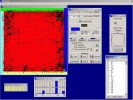Authors
Botia B, Legastelois R, Houchi H, Naassila M.
Lab
Université de Picardie Jules Verne, UFR de Pharmacie, Amiens, France
Journal
Alcohol Clin Exp Res.
Abstract
BACKGROUND:
Anxiety disorders predispose individuals to the development of alcohol dependence in humans. Surprisingly, whether anxiety is a trait influencing the development of alcohol-related behaviors in rodents remains controversial. Here, we addressed the hypothesis of a relationship between basal anxiety levels and the development of ethanol (EtOH)-induced behavioral sensitization (EIBS), a model of neuroadaptations occurring after repeated EtOH exposure which is proposed to play a role in early and recurring steps of addiction.
METHODS:
EtOH-naïve DBA/2J mice were submitted to the elevated plus maze and light/dark box tests to evaluate their basal anxiety levels. Then, mice received daily intraperitoneal injection of saline or 2 g/kg EtOH for 10 days and locomotor activity was immediately monitored. Mice were then split into resistant and sensitized phenotypes based on their increase in locomotion. The relationship between basal anxiety and the development of sensitization was investigated. In addition, we tested the effect of an 8-day-long treatment with 4 mg/kg diazepam, a broad-spectrum benzodiazepine anxiolytic, on the expression of sensitization in both resistant and sensitized mice.
RESULTS:
For the first time, we showed that vulnerability to EIBS is negatively correlated with basal anxiety. Moreover, a diazepam treatment during EIBS procedure increased EtOH-induced hyperlocomotion of resistant mice after 1 week of withdrawal (but not immediately after) without any effect in the group of sensitized mice.
CONCLUSIONS:
This study shows that, in mice, basal anxiety predicts the vulnerability to EIBS. Mice exhibiting low basal anxiety will develop higher EIBS than mice with elevated anxiety levels. Modulation of anxiety by a diazepam treatment during the development of EIBS enhances its expression after 1 week postinduction. Altogether, we demonstrated an inverse relationship between basal anxiety-like behaviors and EIBS vulnerability and that resistance to EIBS vanishes after anxiolytic treatment.
BIOSEB Instruments Used:
Acquisition software: ACTITRACK (ACTITRACK)

 Pain - Thermal Allodynia / Hyperalgesia
Pain - Thermal Allodynia / Hyperalgesia Pain - Spontaneous Pain - Postural Deficit
Pain - Spontaneous Pain - Postural Deficit Pain - Mechanical Allodynia / Hyperalgesia
Pain - Mechanical Allodynia / Hyperalgesia Learning/Memory - Attention - Addiction
Learning/Memory - Attention - Addiction Physiology & Respiratory Research
Physiology & Respiratory Research
 Pain
Pain Central Nervous System (CNS)
Central Nervous System (CNS) Neurodegeneration
Neurodegeneration Sensory system
Sensory system Motor control
Motor control Mood Disorders
Mood Disorders Other disorders
Other disorders Muscular system
Muscular system Joints
Joints Metabolism
Metabolism Cross-disciplinary subjects
Cross-disciplinary subjects Preclinical studies and opioids: role in crisis management in the United States
Preclinical studies and opioids: role in crisis management in the United States 